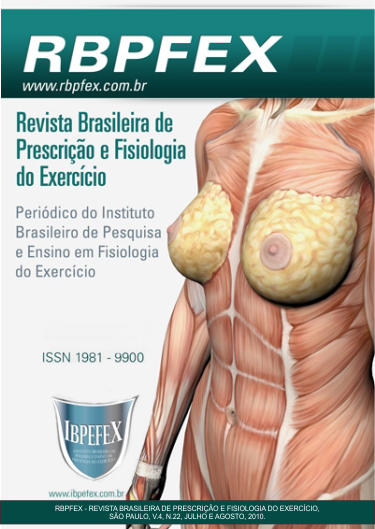Influence of agonist-antagonist method on lower body strength training performance
Abstract
The purpose of this study was to evaluate the capacity of maximum repetitions in leg extension using super-set system in trained man. Eight trained man with a minimum one year of experience in strengthtraining were volunteered for this study (24± 9 years, 174.5±14 cm, 71.1± 21.9 kg). The data were collected in two non-consecutive days. On thefirst day anthropometric measures and a 10 RM test to leg extension and to leg curl were performed. On the second day a super-set was done in leg extension with 10 RM loads to failure preceded of one set of 10 RM in leg curl. A student t-test for dependent samples was applied to meet the goals. In all cases it was adopted level of statistical significance p< 0.05. Significant differences were found when compared knee extension performance in the super-set with traditional training system. The results suggest that super-set can be an effective method of strenght training and can be utilized to maximize work in less time.
References
-American College of Sports Medicine. Position stand on progression models in resistance training forhealthy adults. Med Sci Sports Exerc. Vol. 41. 2009. p. 687-708.
-Aagard, P.; Simonsen, B.E.; Andersen, J.L.; Magnusson, P. Increased rate of force development and neural drive of human skeletal muscle following resistance training. Journal of Applied Physiology. Vol. 93. 2002. p. 1318-1326.
-Baker, D.; Newton, R.U. Acute effect on power output of alternating an agonist and antagonist muscle exercise during complex training. Journal of Strength and Conditioning Research. Vol. 19. 2005. p. 202-205.
-Baratta, R.; Solomonow, M.; Zhou, B.H.; Letson, D.; Chuinard, R.; D'ambrosia, R. Muscular co activation. The role of the antagonist musculature in maintaining knee stability. The American journal of sports medicine. Vol. 26. 1988. p. 231-237.
-Ferreira, A.C.D.; Alcineto, R.R.; Nogueira, F.R.S.; Silva, A.S. Musculação: aspectos fisiológicos, neurais, metodológicos e Nutricionais. XI Encontro de Iniciação à Docência –UFPB-PRG -2008.
-Kellis, E. The effects of fatigue on the resultant joint moment, agonist and antagonist electromyographic activity at different angles during dynamic knee extension efforts. Journal of Electromyography and kinesiology. Vol. 9. Num. 3. 1999. p. 191-199.
-Kraemer, W.J.; Fry, A.C. Strength Testing: Development and Evaluation of Methodology in Physiological assessment of human fitness. Champaign: Human Kinetics; 1995.
-Maynard, J.; Ebben, W.P. The Effects of Antagonist Prefatigue on Agonist Torque and Electromyography. Journal of Strenght and Conditioning Research. Vol. 17. Num. 3. 2003. p.469-474.
-Marchand, E.A.A. Melhoras na força e hipertrofia muscular, proveniente dos exercícios resistidos. Revista digital Efdeportes.com. Vol. 8. Num. 57. 2003.
-Ribeiro, S.R; Tierra-Criollo, C.J; Martins R.A.B.L. Efeitos de diferentes esforços de luta de judô na atividade enzimática, atividade elétrica muscular e parâmetros biomecânicos de atletas de elite. Revista Brasileira de Medicina do Esporte. Vol. 12. Num. 1. 2006. p. 27-31.
-Robbins, D.W; Young, W.B; Behm, D.G; Payne, W.R; Klimstra, M.D. Physical Performance and Electromyographic Responses to an Acute Bout of Paired Set Strength Training Versus Traditional Strength Training. Journal of Strength and Conditioning Research. Vol. 24. Num. 5. 2010. p.1237-1245.
-Simão, R.; Farinatti, P.T.V.; Polito, M.D.; Maior, A.S.; Fleck, S.J. Influence of exercise order on the number of repetitions performed and perceived exertion during resistance exercises. Journal of Strength and Conditioning Research. Vol. 1. 2005. p. 152-156.
Authors who publish in this journal agree to the following terms:
- Authors retain the copyright and grant the journal the right of first publication, with work simultaneously licensed under the Creative Commons Attribution License BY-NC which allows the sharing of the work with acknowledgment of the authorship of the work and initial publication in this journal.
- Authors are authorized to enter into additional contracts separately for non-exclusive distribution of the version of the work published in this journal (eg, publishing in institutional repository or book chapter), with acknowledgment of authorship and initial publication in this journal.
- Authors are allowed and encouraged to post and distribute their work online (eg, in institutional repositories or on their personal page) at any point before or during the editorial process, as this can bring about productive change as well as increase impact and impact. citation of published work (See The Effect of Free Access).






